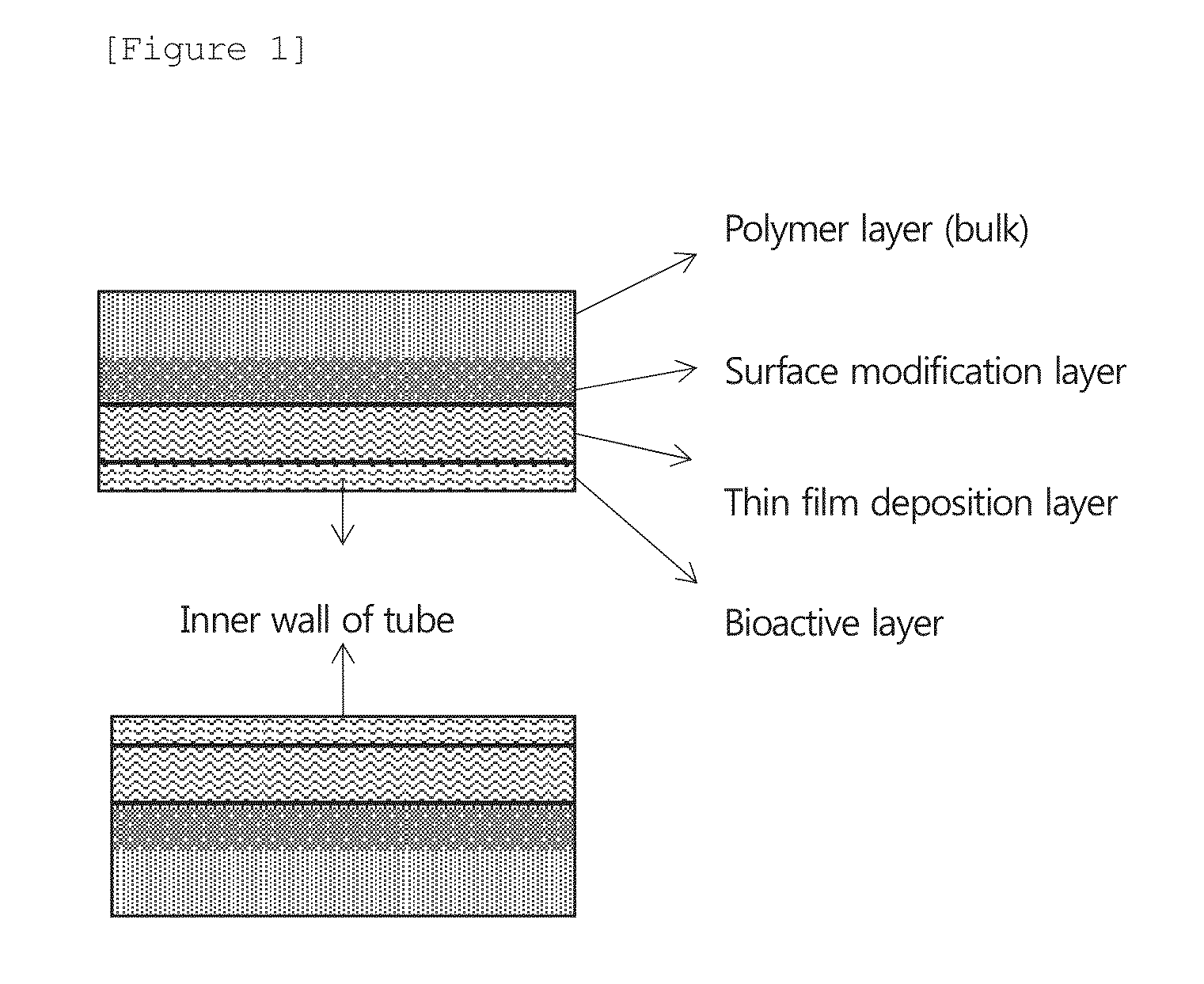Tube with modified inner wall surface using plasma and a preparation method thereof
a technology of inner wall surface and plasma, which is applied in the field of tube preparation, can solve the problems of insufficient supply of blood, tissue damage, and lifelong drug dependence, and achieve the effect of enhancing cell adhesion and preventing aging or imparting adhesiveness
- Summary
- Abstract
- Description
- Claims
- Application Information
AI Technical Summary
Benefits of technology
Problems solved by technology
Method used
Image
Examples
example 1
Modification of Inner Surface of Tube Using Microplasma
[0076]Used as the tube in which the inner surface was to be modified was a biocompatible PTFE tube having an inner diameter of 4 mm, an outer diameter of 6 mm and a thickness of 1 mm. Before surface modification, the tube was cut to a size of 30 cm and impurities were removed from the cut surface using a nitrogen (N2) gun. The PTFE tube was were installed between the gas inlet module and the vacuum evacuation module of a microplasma system, and the inside of the tube was then made vacuous using a rotary type vacuum pump. Meanwhile, a copper electrode having a width of 1.5 cm to enclose the outer surface of the PTFE tube was prepared and fixed at a position distant by 10 cm from the gas inlet module. The copper electrode was connected with an alternating current (AC) source, and a ground electrode was connected to a position at which the tube and the gas inlet module were connected.
[0077]Microplasma was used to modify the inner s...
example 2
Introduction of Thin Film Layer Using Plasma Polymerization
[0078]In order to form a nano organic thin film after surface treatment, acetylene gas (C2H2, 99.99%) was used, and argon gas of 20 sccm was fed into the mixing chamber to induce efficient discharge. The vacuum state of the tube was maintained using a rotary pump, and the inner pressure of the tube containing acetylene gas and argon gas was kept at 220 mTorr. The discharge power of microplasma used for forming the nano organic thin film was 80 W, the frequency and voltage were 40 kHz and 1.3 kV, respectively, and the thin film deposition time was 10 min. The deposition process performed in the microplasma resulted in forming an amorphous hydrocarbon thin film via a plasma polymerization reaction by a radical.
example 3
Enhancement of Cell Adhesion and Hydrophilization Using Microplasma
[0079]The surface deposited nano organic thin film, that is, the amorphous hydrocarbon thin film was modified using a reaction gas so as to have bioactivity. To this end, oxygen (O2, 99.99%) gas and nitrogen (N2, 99.99%) gas were separately used. In the case of surface modification using oxygen, oxygen and argon were fed at 20 sccm each into the mixing chamber using MFC. At this time, the inner pressure of the tube was maintained at 250 mTorr. In the case of surface modification using nitrogen, nitrogen and argon were fed at 20 sccm each into the mixing chamber using MFC, and the inner pressure of the tube was maintained at 260 mTorr. Surface modification using oxygen or nitrogen was carried out under conditions of a plasma power of 80 W, a frequency of 40 kHz, and a voltage of 1.3 kV. Upon oxygen treatment, because a long reaction time causes etching of the thin film, the reaction was carried out for 10, 30 and 60 s...
PUM
| Property | Measurement | Unit |
|---|---|---|
| thickness | aaaaa | aaaaa |
| thickness | aaaaa | aaaaa |
| thickness | aaaaa | aaaaa |
Abstract
Description
Claims
Application Information
 Login to View More
Login to View More - R&D
- Intellectual Property
- Life Sciences
- Materials
- Tech Scout
- Unparalleled Data Quality
- Higher Quality Content
- 60% Fewer Hallucinations
Browse by: Latest US Patents, China's latest patents, Technical Efficacy Thesaurus, Application Domain, Technology Topic, Popular Technical Reports.
© 2025 PatSnap. All rights reserved.Legal|Privacy policy|Modern Slavery Act Transparency Statement|Sitemap|About US| Contact US: help@patsnap.com



